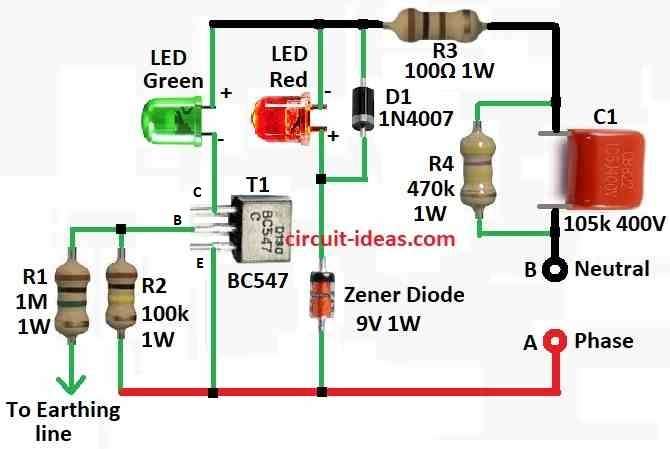Simple Earth Fault Indicator Circuit is like safety guard for electric system.
It checks if electric connects to ground by mistake, like when bad wire touch metal box.
This is very important because if there is an electric leak the machine may break and cause a fire or may shock people.
Circuit watch how much electric goes in ground wire.
Normal time not much electric current goes there may be nothing.
But if something is wrong more electric go in ground wire.
Then circuit see this and make alarm sound like light or buzzer to say problem has happen.
Circuit Working:

Parts List:
| Component | Quantity |
|---|---|
| Resistors | |
| 1M 1/4 watt | 1 |
| 100k 1 watt | 1 |
| 100Ω 1 watt | 1 |
| 470k 1 watt | 1 |
| Capacitors | |
| PPC 105k 400V | 1 |
| Semiconductors | |
| Transistor BC547 | 1 |
| Zener diode 9V 1 watt | 1 |
| Diode 1N4007 | 1 |
| Green 5mm 20mA | 1 |
| Red 5mm 20mA | 1 |
Change the design and settings if one needs depends on what it is used for.
This circuit connect straight to mains power and it checks if wiring is okay or not.
In home wires good earth wire is very important.
If metal part of machine touch live wire by mistake earth help send electric to ground safe way.
This circuit has LED lights to show wire status:
- Red + Green both ON: All wires (phase, neutral, earth) are okay.
- Both OFF: Maybe power cut or phase/neutral wire broken.
- Red ON only: Phase and neutral okay but earth wire maybe broken.
- Green OFF: Show earth wire is not connected or has a problem.
Circuit take power using parts C1 and R3.
C1 capacitor drop high AC voltage to small safe level.
R3 resistor stops too much current coming in fast.
R4 help empty out power in C1 when the circuit is unplug.
Zener diode keep voltage safe so transistor T1 does not get damage.
Zener diode make voltage like square wave which depend on Zener value as in this circuit it is 9V.
When 230V is between phase and neutral then transistor T1 turn ON in negative AC half cycle
Then green LED lights up and show earth wire is good.
This happen because T1 base get voltage from phase to earth.
If earth wire broken there will be no voltage at base and then T1 will stay OFF and in green LED there will be no light.
Red LED will turn ON in positive AC half cycle by showing that phase and neutral are working fine.
To use this circuit:
Put all parts inside 3 pin plug and follow the below connection:
- Point A to Phase pin
- Point B to Neutral pin
- Point C to Earth pin
Then plug in the socket which will show if wiring is correct or not.
Formula:
When current in live and neutral wires are not same that mean some electric current maybe is going to ground (earth).
Earth Fault Indicator Circuit can find this problem.
Below is simple idea to build this type of circuit some useful formulas are also given below.
We use two resistors to make smaller voltage.
This small voltage can go to transistor base or for set reference voltage.
Formula:
Vout = Vin × R2 / R1 + R2
- We can change R1 and R2 to get the voltage one wants.
Transistor Bias:
To turn ON transistor we need to send current to base this is base current (IB).
Formula:
IB = Vin−VBE / RB
where,
- RB is resistor at base
- VBE is around 0.7V voltage drop from base to emitter.
To protect LED from too much current we have used resistor.
How to Build:
To build a Simple Earth Fault Indicator Circuit follow the below mentioned steps for connection:
- Before starting learn safety rules for working with high voltage.
- Wear gloves, shoes and use safe tools.
- Look at the circuit diagram carefully and try to understand what each part do.
- Take all parts one need as shown in the diagram and check values and type.
- If using PCB solder all parts on board same as diagram.
- If using breadboard put parts in right place and connect with jumper wires.
- After building and testing put circuit in safe box.
- Three pin plug case is good idea for this.
- It keep one safe from touching wires.
- Before give power check all wires and parts one more time.
- Use multimeter to see if there are any short circuit or wrong connection.
- When all looks good plug into socket and check LED lights.
- They will show if wiring is okay or not.
- After testing remove from socket.
- Check again and be sure there are no loose wires or parts moving.
- Mains voltage is dangerous.
- If one is not sure how to build or test the circuit ask someone with experience or professional person to help.
Conclusion:
Simple Earth Fault Indicator Circuit is very important part in electric system.
It finds earth fault early and gives the warning.
This help stop electric shock, fire or damage to machines.
It checks how much current goes in earth wire.
This help keep place safe at home or factory.
Leave a Reply